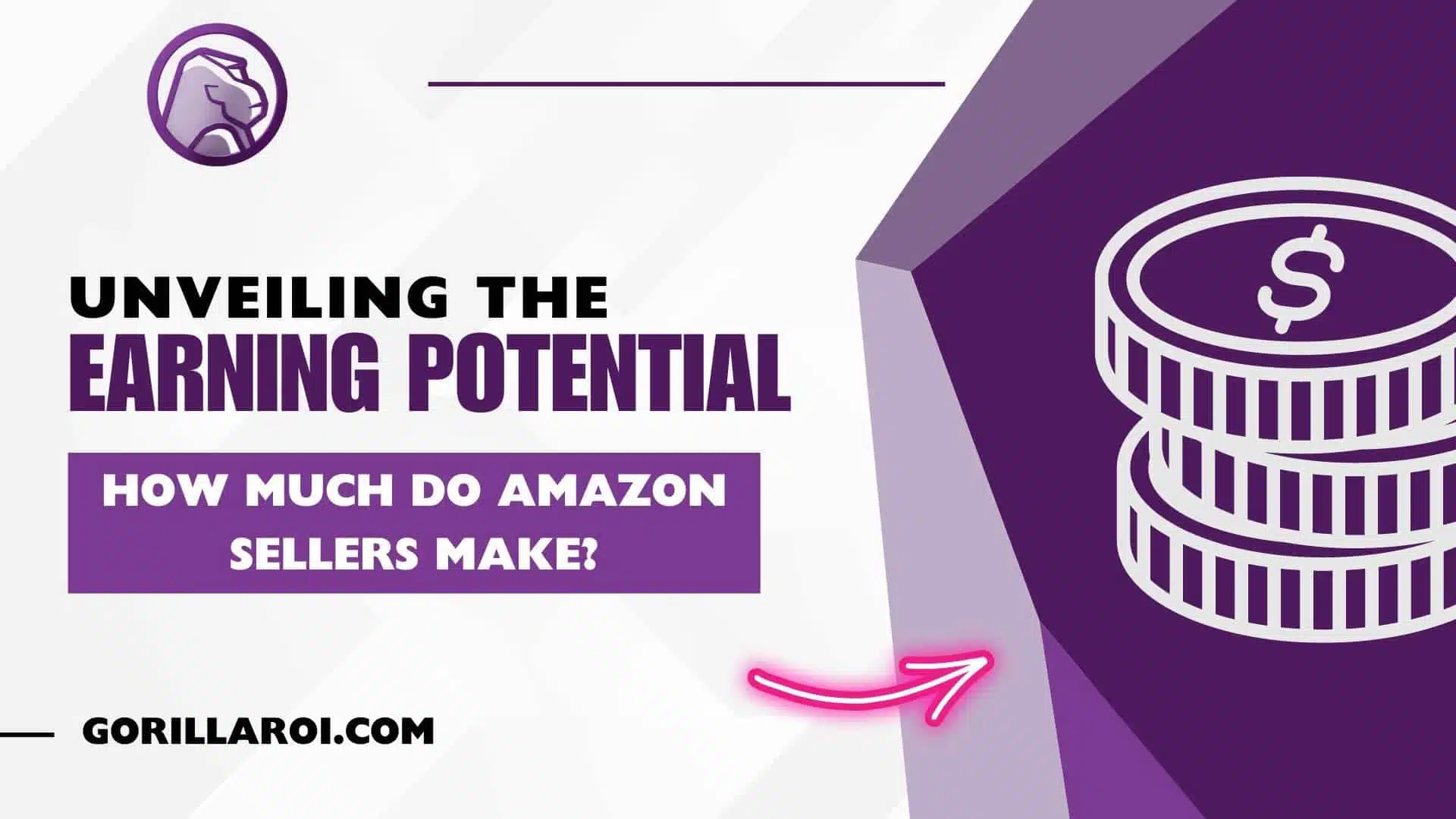Article Summary (TL;DR)
✅ Amazon offers various ad types like Sponsored Products, Brands, and Display Ads to boost product visibility and sales.
✅ FBA sellers benefit from increased visibility, keyword targeting, and brand awareness through Amazon advertising.
✅ Setting up Amazon ads involves creating campaigns, choosing targeting options, monitoring performance, and continuous optimization.
Amazon charges storage fees for a reason, and over recent months, Amazon has considerably increased the Amazon storage price they charge FBA sellers (i.e., increased Amazon FBA fees and FBA fulfillment fees).
We’ll go through what you need to know about Amazon storage fees, strategies to reduce them, the current costs, and how to calculate your estimated Amazon storage pricing.
Lessen any cash flow issues, and your bank account will thank you as an Amazon seller.
Note: We have a guide on what wholesale products to sell on Amazon.
What are Amazon storage fees?
The bulk of Amazon storage fees comes from Amazon charging you to keep your inventory in their fulfillment centers (i.e., fulfillment fee or fulfillment fees). It’s usage based.
You can check out our income report to see how we do things. There are also amazon fba size chart information on their website.
Amazon determines your storage fees by calculating the daily average volume and your rate is based on the product type, size tier and time of year.
The four variables again:
- daily average volume (there is also amazon fba daily payments)
- product type (regular or Dangerous Goods)
- size tier
- time of year
How often does amazon FBA pay? You’ll pay the storage fee monthly, typically between the 7th and 15th, of the following month. The usage is calculated once the month is officially over. It is not calculated and paid in real-time.
Daily Average Volume
The daily average volume is simple. It’s the total volume in cubic feet (or cubic meters depending on your FC location) of the inventory you have stored in Amazon’s fulfillment centers.
We also have an FBA inventory reimbursement guide to help you.
There is an average Amazon package size, Amazon standard size dimensions, and Amazon FBA size tiers USA that should be considered.
For each SKU and for each FC location, your daily average volume is recorded. It’s a daily calculation because as you sell your items, the volume is subtracted from the total volume.
This sounds complicated, and there are Amazon automated services out there. Although, we don’t recommend them. If you want to succeed on Amazon, then you should be familiar with these terms.
If you started the month with 1000 cubic ft., and you sold half by the end of the month, Amazon isn’t going to charge you the monthly fee based on the ending inventory storage volume of 500 cu ft. This would be great for sellers because you start with 1000, but pay for 500. But Amazon wants to maximize its returns as well. Hence you pay a daily average.

Product type determines Amazon storage fees
Most sellers sell regular products. But if you sell dangerous goods, then the fees get expensive because the inventory is placed in a fulfillment center that handles dangerous goods.
There is a limited number of dangerous goods warehouses so the cost to ship will increase, the time to check in will increase, there are storage limits on how much you can send in, and the fulfillment of each DG product is at least 30-40% more expensive.
Do you want to learn more about products? You should check out our retail arbitrage article.
For example, a non-dangerous good product weighing 10oz will cost $3.22 to fulfill. A dangerous good product weighing 10oz costs $4.28.
A difference of $1.06 or 33% between the two.
In your inventory health report, it will show whether your product is considered a standard or dangerous good. You can get this report and data directly into Google Sheets using our custom G Sheets addon and formula called INVENTORYHEALTH().

With Gorilla ROI, you can load all of your storage fees and storage-related data directly into Google sheets automatically.
No more nasty surprises.
Size tier of products
The bigger your products, the higher your Amazon storage fees. Everything is cubiscanned at check-in.
With the new dimensional weight changes to calculate your fees and storage use, oversized goods got a lot more expensive.
- Here’s Amazon’s page on product size tiers.
- Amazon’s page on dimensional weight.
- We have a free spreadsheet calculator to help you calculate your fees and profit.


Fees based on time of year
The time of the year you store your inventory in the Amazon warehouse plays a big role in your total Amazon storage fees. On Amazon’s monthly storage fees page, you’ll see the breakdown by quarter.
Check out this monthly inventory storage fees matrix.
| Non-dangerous goods products | ||
| Month | Standard-size | Oversize |
| January – September | $0.83 per cubic foot | $0.53 per cubic foot |
| October – December | $2.40 per cubic foot | $1.20 per cubic foot |
| Dangerous goods products | ||
| Month | Standard-size | Oversize |
| January – September | $0.99 per cubic foot | $0.78 per cubic foot |
| October – December | $3.63 per cubic foot | $2.43 per cubic foot |
Q1 to Q3 is the cheapest while Q4 balloons to 3x or more of the cost from Q1 to Q3.
As you can see, the key to making profits is to maintain smart inventory management during Q4 when the shopping season is at its peak.
How is the monthly inventory storage fee calculated?
The monthly storage fees are calculated based on the daily average volume of your goods in the fulfillment centers in cubic feet.
Also consider that there are amazon holiday storage fees.
In your storage fee report, these are the columns you need to look for. With Gorilla ROI, we’ve combined all the volumes across all the fulfillment centers to make it easier to see the total estimated storage fee per ASIN.

Product rates are categorized into two: oversize and standard-size. Standard-size products take up less space, but the configuration of the space is a bit more complex than oversize products. Also, the rate for oversized goods is higher than standard-size since the storage fee is calculated based on the volume measurement in cubic feet.
You can also see your usage at the bottom of the manage FBA shipments page. You can also use an AWS calculator.

Long-term storage fees
This is the second type of storage fee you should be familiar with. Also known as overage fees, long-term storage fees are applied on goods that have been in the Amazon fulfillment centers for more than 365 days, and Amazon imposes long-term storage fees in addition to the monthly storage fee.
The long-term storage fee has multiple factors to it.
You are billed the greater of either:
- applicable cubic foot fee
- or the applicable per unit fee

This is to make sure that you pay the max. Long term storage is not cheap.
Amazon isn’t a holding warehouse for sellers to send boatloads of inventory without selling it. The long-term fee is to force FBA sellers to improve their inventory management and increase sell-through to keep the warehouses profitable and efficient.
Tracking long-term inventory storage fee
Go to the recommended removal report to see how your inventory is aging. Then look up “Recommended Removal Quantity (Sellable)” column.

With Gorilla ROI, use our INVENTORYHEALTH() function to get this information directly into your spreadsheet automatically. Nothing to download. It just loads for you.
Best practices for avoiding long-term storage fees
Adopt these best practices to avoid long-term inventory storage fees:
Start with a small quantity
It’s best to drip your inventory into Amazon because their prices are not the cheapest.
If you are launching a new product, it’s best to start with a small number of your goods before expanding. This will help you to gauge whether your product will sell or not.
Store additional inventory outside of Amazon FBA
Another great option to avoid paying long-term inventory storage fees is to use a 3PL or your warehouse—places like your house, office, or even a low-cost storage unit.
Storing your inventory outside of Amazon FBA is also a good way to keep lower inventory volumes at the Amazon fulfillment center. Plus, you can easily ship your goods to the Amazon warehouse when inventory is low so that you don’t run out of stock. This approach will save you a lot of money, especially if your manufacturer is overseas.
Run discounts on at-risk inventory
If you have inventory getting close to 12 months old, consider running deep discounts to sell through the old inventory. Although you’ll likely sell it at a loss, it will be cheaper than pulling it out and shipping it back to your location or disposing of it.
Another way to increase sales volume to liquidate is to throw ads and PPC at it. Headline Search Campaigns, Sponsored Product Campaigns, Video campaigns, and other ads to move the inventory.
Optimize detail pages to grow sales
Optimizing your details pages is another best practice to adopt if the inventory cleanup date is close and you have a lot of goods on the shelf that is not sold. Check all the important components of your pages and optimize those that need to be optimized to drive sales. Vital details like product description and image quality shouldn’t be treated lightly. Additionally, please pay attention to your product reviews, as they have a way to sway online shoppers.
Remove inventory
If you have implemented the above strategies and the product isn’t selling, you’ll have to create a removal or disposal order.
Do some math to see whether a removal order makes sense to offset the Amazon storage fees. Sometimes it is cheaper to dispose of the inventory than remove it from the FC.
You can do a quick calculation from the Inventory Health Report to get a projected long-term storage fee. Deduct whatever fee you get from your profit margin to see the impact of the fees. Using this strategy will make sense if the fees will make you lose money.
Summary
Amazon storage fee is a very important topic that every FBA seller should be aware of. If you don’t deploy strategies to avoid the long-time storage fee, it could end up “eating” deep into your potential profit. Also, if you’re not careful with Amazon storage fees, it could even cause you to lose the money you invested in purchasing inventory.
Regularly assess the risks of your storage fee and adjust your strategies accordingly to minimize the impact on your margins. If you don’t know, Amazon’s fee is continuously rising as more sellers open storefronts.
With Amazon experiencing rapid growth, the demand for space in the company’s fulfillment centers is also increasing. And space is such an important factor, which is why it doesn’t come free of charge. With the strategies I have shared in this post, you will be well on becoming a successful FBA seller.
Frequently Asked Questions
What is the difference between Amazon storage fees and FBA fees?
Amazon usually charges a fee for helping you to manage your inventory in their warehouses, along with packing and delivery. Amazon charges storage fees for a reason and over recent months, Amazon has made a considerable increase in the storage fees they charge FBA sellers.
What are Amazon storage fees?
The bulk of Amazon storage fees is obviously Amazon charging you to keep your inventory in their fulfillment centers. Amazon determines what to charge you by calculating the daily average volume that your inventory occupies in cubic feet. The daily average volume is used to estimate and show you your monthly costs.
Do you pay for Amazon storage?
Certainly, FBA sellers are subjected to storage fees to enable Amazon to manage all inventory. Amazon charges $0.15 per unit or $6.90 per cubic foot, whichever is greater. The charge is imposed on inventory that has been in the fulfillment center for more than one year without sales.
How do I find my FBA storage fees?
The best way to find your FBA storage fees is to click on the Inventory Dashboard. Once you click on the dashboard, scroll down and click on the FBA inventory age box. From the age box, you will find the inventory age for your units and the estimated long-term storage fees.
Do you need storage for Amazon FBA?
Of course, you need storage for Amazon FBA. The storage limit for individual selling accounts is 10 cubic feet. This storage limit doesn’t change and is only available to sellers using Individual accounts.
How do I avoid Amazon storage fees?
Some of the best ways to avoid Amazon storage fees include using Amazon promotions and sponsored product ads, managing inventory levels from the start, and taking advantage of free removal promotions.his fee is what is known as the FBA fee. On the other hand, all sellers on the Amazon platform usually pay a fee when they make an actual sale.
How are Amazon storage fees calculated?
Storage fees = Volume per unit x average daily units x applicable rate. The applicable rate depends on the size and nature of the product.
Comments
Related Posts

Different Types of Amazon Ads: Amazon Advertising Options for FBA Sellers
There are different types of Amazon ads. Amazon offers several…

How Amazon Sellers Use the Amazon Wishlist to Boost Sales
Amazon is a vast and competitive marketplace where millions of…

Unveiling the Earnings Potential: How Much Do Amazon Sellers Make?
Are you curious about how much do Amazon sellers make?…
Ready to sync your Amazon data to Google Sheets?
Gorilla ROI is the easiest way to automatically sync your Amazon data to Google Sheets 24/7 to match your business needs. Uncover actionable insights to sell more and beat the competition.







Leave a Reply